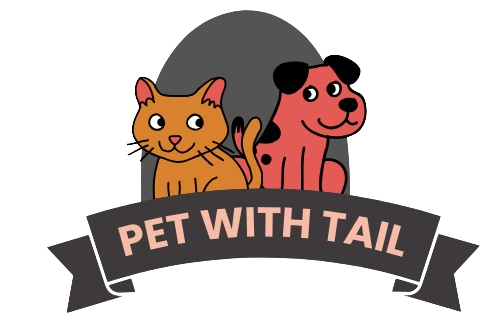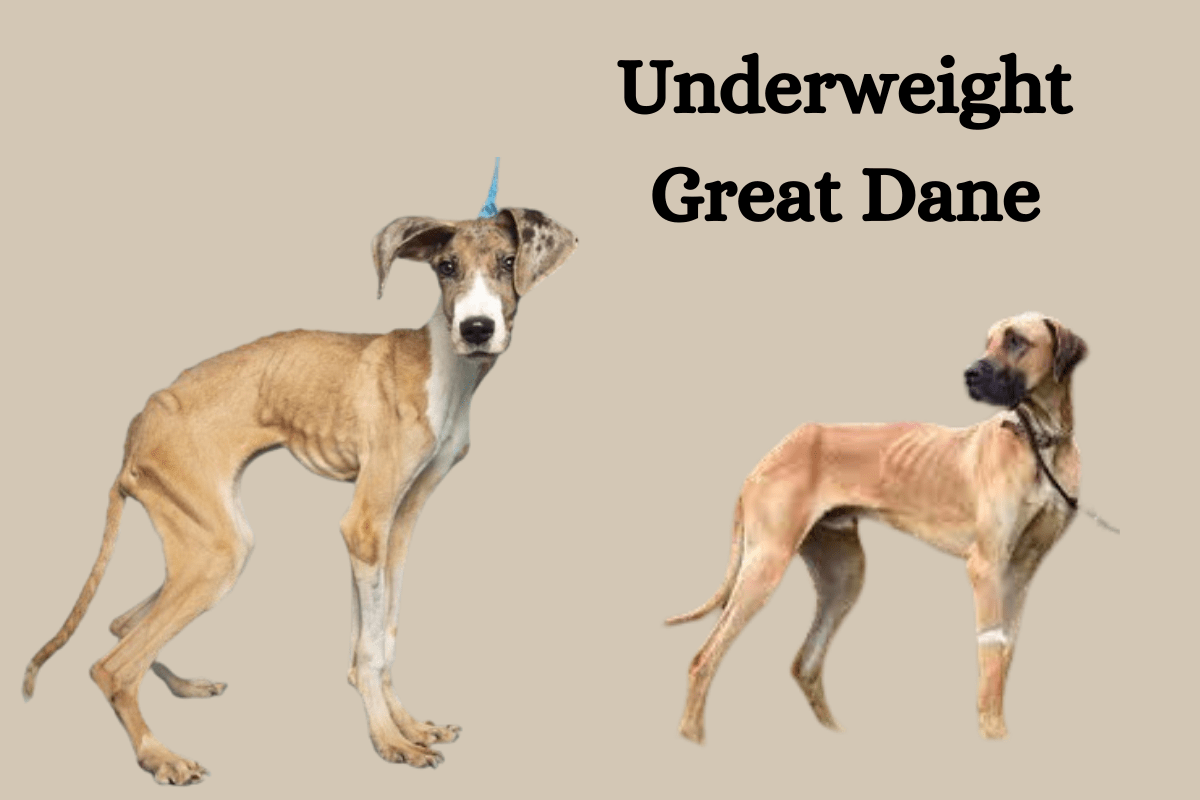Do you have a great Dane who is underweight and struggles to gain weight? Are you worried about his health and well-being? If so, you are not alone. Many great Dane owners face the same problem of Underweight Great Dane and wonder how to help their beloved dogs.
An underweight Great Dane is a serious issue that can affect your dog’s quality of life and happiness. It can also lead to various health problems, such as poor immunity, joint pain, muscle loss, and organ failure.
Therefore, it is important to address this problem as soon as possible and find out the best way to help your skinny Great Dane gain weight and stay healthy. In this article, we will discuss the causes and solutions for losing weight in Great Dane, and how to monitor his weight and body condition.
We will also provide tips and recommendations on what to feed your underweight great Dane, and how to improve his overall health and well-being. By the end of this article, you will have a better understanding of how to help your thin great Dane and make him happy and healthy.
Contents
- 1 Causes of Underweight Great Dane
- 2 Solutions for Underweight Great Dane
- 3 How Much Food Does a Great Dane Need?
- 4 How to Monitor Your Great Dane’s Weight and Body Condition
- 5 What is the minimum weight for a Great Dane?
- 6 Why you should not overfeed your Great Dane?
- 7 Conclusion
- 8 FAQs About Underweight Great Dane
Causes of Underweight Great Dane
Before you can help your underweight Great Dane gain weight, you need to understand the possible causes of his condition. Many factors can lead to an underweight Great Dane, such as:
- Genetics: Some great Danes are naturally leaner and have a faster metabolism than others. This means they burn more calories and need more food to maintain their weight. If your Great Dane is underweight but otherwise healthy and active, he may just have a genetic predisposition to be thin.
- Health conditions: Certain health conditions can affect your great Dane’s appetite, digestion, absorption, and metabolism, resulting in weight loss. Some of these conditions include worms, parasites, infections, allergies, diabetes, thyroid problems, kidney disease, liver disease, cancer, etc. If you suspect your Great Dane has any of these conditions, you should consult your veterinarian as soon as possible and get him treated.
- Stress: Stress can also cause your great Dane to lose weight, as it can reduce his appetite, increase his cortisol levels, and affect his immune system. Stress can be caused by various factors, such as changes in environment, routine, or family, separation anxiety, noise, boredom, loneliness, etc. If your Great Dane is stressed, you should try to identify and eliminate the source of stress and provide him with more comfort, attention, and stimulation.
- Other factors: There may be other factors that can contribute to your Great Dane’s weight loss, such as poor quality or quantity of food, dental problems, competition with other pets, medication side effects, etc. You should check your Great Dane’s food and feeding habits, and make sure he is getting enough appropriate food for his size, age, and activity level. You should also check his teeth and gums, and make sure he is not having any pain or difficulty in chewing or swallowing. You should also monitor his interaction with other pets, and make sure he is not being bullied or intimidated by them. You should also review his medication, and make sure he is not having any adverse reactions to them.
To identify if your Great Dane is underweight, you can use two methods: body condition score and weight chart. The body condition score is a visual and tactile assessment of your Great Dane’s body fat and muscle mass.
You can use a scale from 1 to 9, where 1 is emaciated, 5 is ideal, and 9 is obese. You can look at your great Dane’s ribs, waist, abdomen, and spine, and feel them with your hands. A healthy great Dane should have a visible waist, a slight tuck in the abdomen, and a thin layer of fat covering the ribs and spine.
An underweight Great Dane will have a very pronounced waist, a severe tuck in the abdomen, and no fat covering the ribs and spine. You can see some examples or images of underweight and healthy great Danes below for comparison.
A weight chart is a numerical measurement of your Great Dane’s weight about his height and breed standard. You can use a scale or a tape measure to weigh and measure your Great Dane and compare his results with the average weight range for his breed and gender.
A healthy male Great Dane should weigh between 120 and 200 pounds, and a healthy female Great Dane should weigh between 100 and 130 pounds. An underweight great Dane will weigh less than the minimum weight for his breed and gender. You can see some examples or images of underweight and healthy great Danes below for comparison.
Related Dogs Breeds:
When Do Rough Collies Stop Growing?
Solutions for Underweight Great Dane
Now that you know the possible causes of skinny Great Dane, you may be wondering how to help your dog gain weight and stay healthy. Fortunately, there are some effective solutions that you can try, such as:
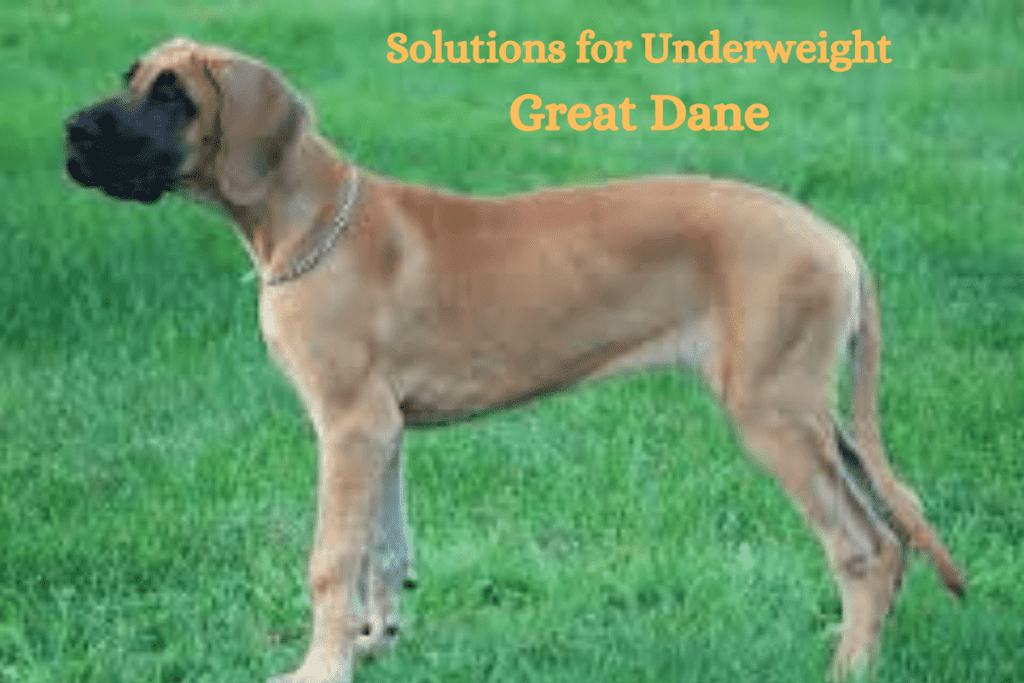
- Feeding more frequently: if you are worried about why your Great Dane is so skinny, One of the simplest ways to help your underweight Great Dane gain weight is to feed him more often. Instead of giving him one or two large meals a day, you can split his food into smaller portions and feed him three or four times a day. This way, you can increase his calorie intake and prevent him from feeling too full or bloated. You can also add some healthy snacks between meals, such as boiled eggs, cheese, yogurt, or peanut butter.
- Adding high-calorie supplements: Another way to help your underweight Great Dane gain weight is to add some high-calorie supplements to his food. These supplements can provide extra calories, protein, fat, vitamins, and minerals that your dog may need to gain weight and muscle. Some examples of high-calorie supplements are Dyne High-Calorie Liquid, Miracle Vet High-Calorie Weight Gainer, or Bully Max High-Performance Dog Food. You can follow the instructions on the label or consult your veterinarian for the proper dosage and frequency.
- Reducing exercise: While exercise is important for your Great Dane’s health and well-being, too much exercise can also cause him to lose weight. If your Great Dane is underweight, you may want to reduce his exercise level and intensity until he reaches his ideal weight. You can still take him for walks and play with him, but avoid strenuous activities that can burn too many calories, such as running, jumping, or agility training. You can gradually increase his exercise once he gains enough weight and strength.
- Consulting your veterinarian: Sometimes, you wonder if you can see your underweight Great Dane spin and you may need more than just dietary changes and supplements. He may have an underlying health condition that requires medical attention and treatment. If you notice any signs of illness or injury, such as vomiting, diarrhea, lethargy, pain, or bleeding, you should take your Great Dane to your veterinarian as soon as possible. Your veterinarian can diagnose the problem and prescribe the appropriate medication or therapy. Your veterinarian can also advise you on the best feeding plan and weight management for your Great Dane.
How Much Food Does a Great Dane Need?
A Great Dane’s food needs depend on several factors, such as age, size, activity level, and health condition. According to a Great Dane feeding chart by Hello Danes, the average daily food intake for a Great Dane is as follows:
- Three to six months old male puppy:
- four to eight cups of food each day 3–6 cups of food per day
- for a female puppy between the ages of 3 and 6 months
- 8 to 12 months old male puppy:
- 6 to 10 cups of food each day 8 to 12-month-old
- female puppy: 5 to 8 cups of food each day
- Male adult of 1 to 2 years: 9 to 15 cups of food a day
- Female adults of 1 to 2 years: 8 to 12 cups of food a day
- Male senior of 7 years and older: 6 to 9 cups of food a day
- Female seniors of 7 years and older: 5 to 7 cups of food a day.
These are only general guidelines, and you may need to adjust the amount of food according to your Great Dane’s individual needs. You can use a body condition score to assess if your Great Dane is at a healthy weight. A healthy Great Dane should have a visible waist, a slight tuck in the abdomen, and a thin layer of fat covering the ribs and spine. On the other hand, you can see the ribs and spine of a skinny Great Dane
How to Monitor Your Great Dane’s Weight and Body Condition
Once you have implemented the solutions for underweight Great Dane, you need to monitor your dog’s weight and body condition regularly. This will help you to see if your dog is gaining weight at a healthy pace and to adjust his feeding plan accordingly. Here are some ways to monitor your Great Dane’s weight and body condition:
- Weigh your Great Dane: The most accurate way to measure your Great Dane’s weight is to use a scale or a tape measure. You can use our free tool to track your Great Dane’s growth and weight over time. You can also compare your great Dane’s weight with the average weight range for his breed and gender. A healthy male Great Dane should weigh between 120 and 200 pounds, and a healthy female Great Dane should weigh between 100 and 130 pounds. An underweight great Dane will weigh less than the minimum weight for his breed and gender.
- Check your Great Dane’s body condition score: Another way to assess your Great Dane’s weight is to use the body condition score method. This is a visual and tactile assessment of your Great Dane’s body fat and muscle mass. You can use a scale from 1 to 9, where 1 is emaciated, 5 is ideal, and 9 is obese. You can look at your great Dane’s ribs, waist, abdomen, and spine, and feel them with your hands. A healthy great Dane should have a visible waist, a slight tuck in the abdomen, and a thin layer of fat covering the ribs and spine. An underweight Great Dane will have a very pronounced waist, a severe tuck in the abdomen, and no fat covering the ribs and spine. You can see some examples or images of underweight and healthy great Danes below for comparison.
- Look for signs of health problems: Sometimes, your underweight Great Dane may have some underlying health problems that affect his weight and growth. Some of these problems include worms, parasites, infections, allergies, diabetes, thyroid problems, kidney disease, liver disease, cancer, etc. If you notice any signs of illness or injury, such as vomiting, diarrhea, lethargy, pain, or bleeding, you should take your Great Dane to your veterinarian as soon as possible. Your veterinarian can diagnose the problem and prescribe the appropriate medication or therapy. Your veterinarian can also advise you on the best feeding plan and weight management for your Great Dane.
What is the minimum weight for a Great Dane?
The minimum weight for a Great Dane depends on the age, gender, and standard of the dog. According to Wikipedia, the minimum weight for a Great Dane over 18 months of age is 120 lb (54 kg) for males and 100 lb (45 kg) for females. However, the American Kennel Club dropped the minimum weight requirement from its standard. The Kennel Club in the UK still maintains the minimum weight for adult Great Danes as 54 kgs (120 lbs) for males and 46 kgs (100 lbs) for females.
Minimum Weight for a Great Dane
Age and Gender
The minimum weight for a Great Dane varies depending on the age and gender of the dog. By the time they are between one and a half and two years old, Great Danes are deemed fully developed. However, even after reaching their full adult height, they will still build muscles and thus can get heavier. The growth also depends on nutrition and overall health, so it is important not to overfeed or underfeed the dog.
According to a growth chart by K9 Web, the average weight for a male Great Dane puppy at 6 months is 75.5 lb (34.2 kg), while the average weight for a female Great Dane puppy at the same age is 69.5 lb (31.5 kg). By 12 months, the average weight for a male Great Dane puppy is 115 lb (52.1 kg), and the average weight for a female Great Dane puppy is 99 lb (44.9 kg).
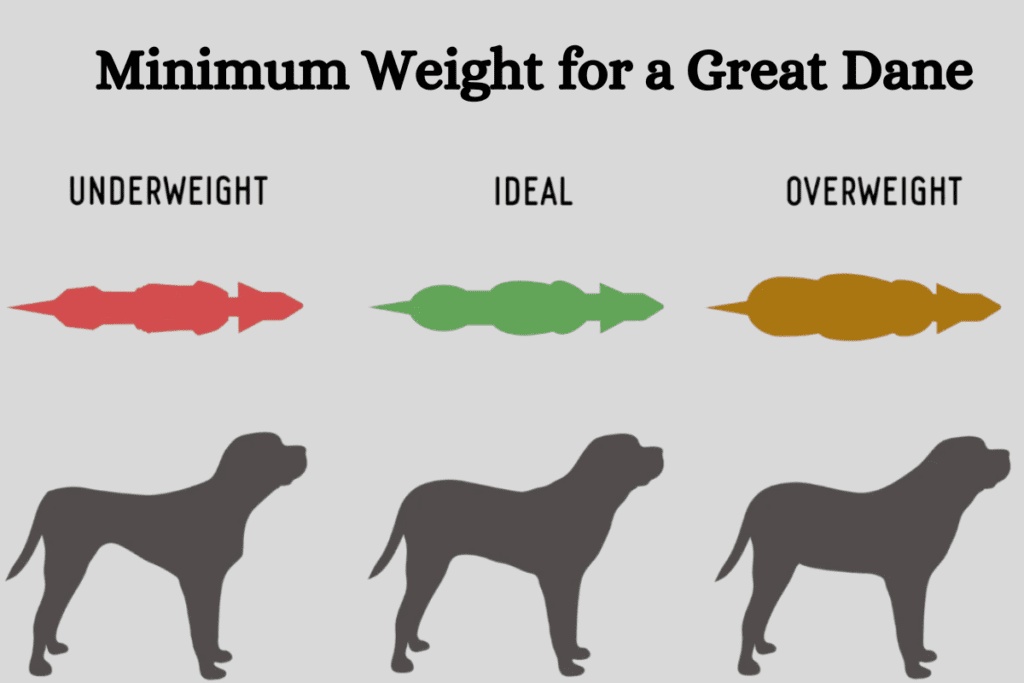
Standard and Breed
The minimum weight for a Great Dane also depends on the standard and breed of the dog. There are two sizes of Great Danes, namely American and European. American Great Danes are typically smaller than their European counterparts, with narrow chests and fewer muscles. European Great Danes are huge dogs that have even exceeded 240 pounds (108 kg).
Different kennel clubs may have different standards for the minimum weight for a Great Dane. For example, the American Kennel Club does not specify a minimum weight for a Great Dane but only states that the weight should be proportionate to the height. The Kennel Club in the UK, however, specifies the minimum weight for an adult Great Dane over 18 months as 54 kgs (120 lbs) for males and 46 kgs (100 lbs) for females.
Suggested:
Why you should not overfeed your Great Dane?
Bloat: Bloat is a life-threatening condition where the stomach fills with gas and twists, cutting off the blood supply to the organs. It can cause severe pain, shock, and death within hours. Overfeeding can increase the risk of bloat by causing the stomach to expand and contract rapidly, or by creating excess gas production. Bloat is more common in large and deep-chested breeds, such as Great Danes.
- Obesity: Obesity is a condition where the body has excess fat that can impair the health and well-being of the dog. It can lead to various diseases, such as diabetes, arthritis, heart disease, respiratory problems, and cancer. Overfeeding can cause obesity by providing more calories than the dog can burn. Obesity is more prevalent in older and less active dogs, such as Great Danes.
- Orthopedic disorders: Orthopedic disorders are problems that affect the bones, joints, muscles, and tendons of the dog. They can cause pain, lameness, deformity, and reduced mobility. Overfeeding can contribute to orthopedic disorders by putting extra stress on the skeletal system, or by causing nutritional imbalances that affect the growth and development of the bones and cartilage. Orthopedic disorders are more frequent in large and giant breeds, such as Great Danes.
Therefore, it is important to feed your Great Dane the right amount and type of food and to monitor his or her weight and body condition regularly. You can use a feeding chart1 or a body condition score to determine the appropriate food intake and weight range for your Great Dane. You can also consult your veterinarian for more advice on feeding your Great Dane.
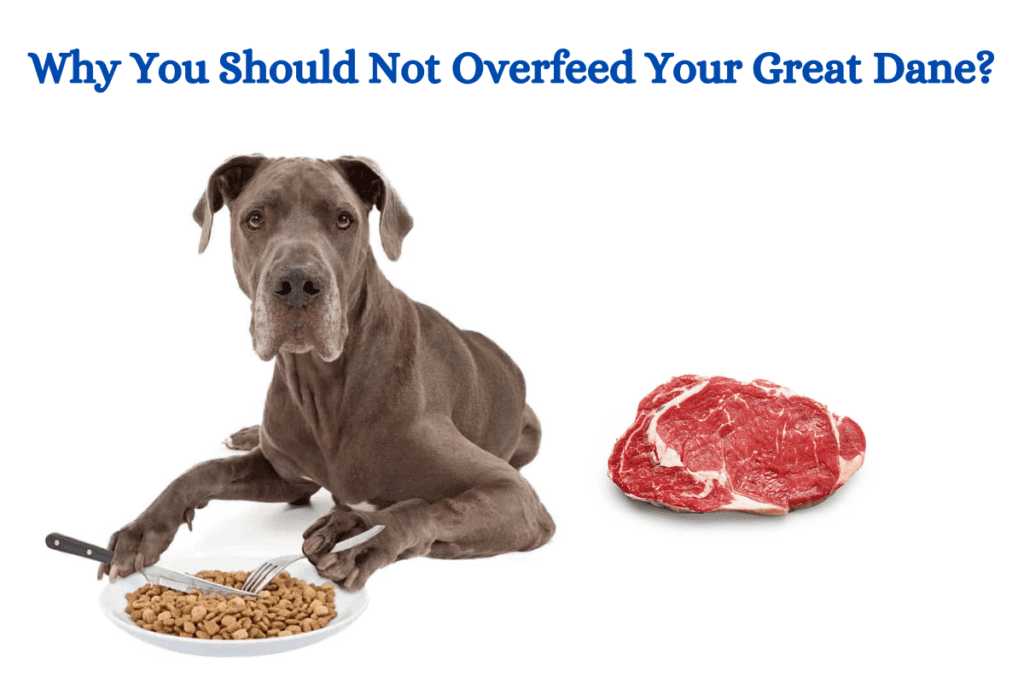
Conclusion
You’ve learned how to help your underweight great Dane gain weight and stay healthy. You’ve discovered the possible causes of his condition, such as genetics, health problems, stress, or other factors.
You’ve also learned effective solutions, such as feeding more frequently, adding high-calorie supplements, reducing exercise, or consulting your veterinarian. And you’ve learned how to monitor your great Dane’s weight and body condition, using the body condition score and weight chart methods.
Now you have the knowledge and the tools to help your underweight Great Dane achieve his ideal weight and well-being. By following these tips and recommendations, you can improve your Great Dane’s quality of life and happiness. You can also prevent or treat any health issues that may arise from being underweight.
We hope this article has been helpful and informative for you. And if you found this article useful, please share it with your friends and fellow Great Dane owners. Thank you for reading!
FAQs About Underweight Great Dane
Q: What are the causes of underweight Great Dane?
- A: Many factors can lead to an underweight great Dane, such as genetics, health conditions, parasites, stress, poor quality or quantity of food, dental problems, competition with other pets, or medication side effects. You should consult your veterinarian if you suspect your Great Dane has any of these issues and get him or her treated.
Q: How can I help my underweight great Dane gain weight?
- A: You can help your underweight great Dane gain weight by feeding him or her more frequently, adding high-calorie supplements to his or her food, reducing exercise, or consulting your veterinarian. You should also monitor your great Dane’s weight and body condition regularly, using the body condition score and weight chart methods.
Q: What are the best foods for underweight Great Dane?
- A: The best foods for underweight great Dane are those that are high in calories, protein, fat, vitamins, and minerals, and that are suitable for his or her size, age, and activity level. You can use products that are specially designed for weight gain, such as Dyne High-Calorie Liquid, [Miracle Vet High-Calorie Weight Gainer], or [Bully Max High-Performance Dog Food]. You can also add some healthy snacks between meals, such as boiled eggs, cheese, yogurt, or peanut butter.
Q: How much food does a great Dane need?
- A: The amount of food that a great Dane needs depends on several factors, such as age, size, activity level, and health condition. According to a Great Dane feeding chart by Hello Danes1, the average daily food intake for a Great Dane is as follows:
- Male puppy of 3 to 6 months: 4 to 8 cups of food a day
- Female puppy of 3 to 6 months: 3 to 6 cups of food a day
- Male puppy of 8 to 12 months: 6 to 10 cups of food a day
- Female puppy of 8 to 12 months: 5 to 8 cups of food a day
- Male adult of 1 to 2 years: 9 to 15 cups of food a day
- Female adult of 1 to 2 years: 8 to 12 cups of food a day
- Male senior of 7 years and older: 6 to 9 cups of food a day
- Female seniors of 7 years and older: 5 to 7 cups of food a day
These are only general guidelines, and you may need to adjust the amount of food according to your great Dane’s individual needs. You can use a body condition score to assess if your Great Dane is at a healthy weight.
Q: What are the health risks of an underweight Great Dane?
- A: Underweight Great Dane is a serious issue that can affect your dog’s quality of life and happiness. It can also lead to various health problems, such as poor immunity, joint pain, muscle loss, and organ failure. Therefore, it is important to address this problem as soon as possible and find out the best way to help your underweight Great Dane gain weight and stay healthy.
